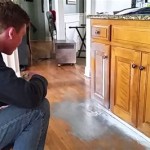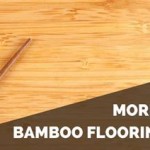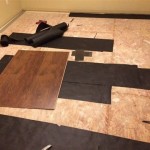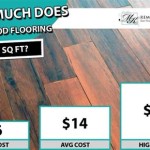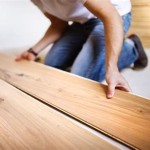How to Remove Double-Sided Carpet Tape From a Wood Floor
Double-sided carpet tape is often used to secure rugs and carpets to wood floors, preventing slips and keeping the floor coverings in place. However, the adhesive used in these tapes can leave a stubborn residue when the tape is removed. This residue can be unsightly, difficult to clean, and, in some cases, can even damage the finish of the wood floor. Removing double-sided carpet tape and its residue from a wood floor requires a systematic approach and the use of appropriate tools and cleaning agents. This article provides a comprehensive guide to safely and effectively removing double-sided carpet tape from wood flooring, minimizing the risk of damage to the underlying material.
Understanding the Adhesive and Its Behavior
The first step in effectively removing double-sided carpet tape is understanding the nature of the adhesive itself. Carpet tapes typically use a pressure-sensitive adhesive (PSA) that bonds strongly to both the carpet and the wood floor. These adhesives vary in strength and composition. Some are rubber-based, while others are acrylic-based. The type of adhesive used will influence the optimal removal method. Over time, the adhesive can harden and become more resistant to solvents, making removal more challenging. Factors such as temperature, humidity, and exposure to sunlight can also affect the adhesive's properties and its bond to the wood floor.
Furthermore, the type of finish on the wood floor plays a crucial role. Polyurethane finishes, for instance, are relatively durable and can withstand more aggressive cleaning methods compared to waxed or oiled finishes. It is essential to identify the type of finish on the floor before attempting any removal process to avoid damaging the surface.
Before proceeding with any large-scale removal, testing a small, inconspicuous area is always recommended. This 'spot test' allows one to assess the effectiveness of the chosen removal method and to check for any adverse reactions with the floor's finish. A successful spot test will minimize the risk of widespread damage and ensure a more predictable outcome.
Methods for Removing Double-Sided Carpet Tape and Residue
Several methods can be employed to remove double-sided carpet tape and its residue from wood floors. The choice of method depends on the severity of the adhesion, the type of adhesive, and the type of floor finish. Below are some common techniques, progressing from the least to the most aggressive.
1. Manual Removal with a Plastic Scraper:
This method is best suited for relatively fresh adhesive or situations where the tape is easily peeled away. Use a plastic scraper – a putty knife with a plastic blade is ideal – to gently lift the edge of the tape and begin peeling it back at a shallow angle. Avoid using metal scrapers, as these can easily scratch or gouge the wood floor. Work slowly and methodically, applying consistent pressure to separate the tape from the surface. If the tape tears or leaves residue behind, proceed to one of the methods described below. After removing the tape, any remaining residue can sometimes be rolled off by pressing firmly with a clean thumb or finger and rolling it up into a ball.
2. Heat Application:
Heat can soften the adhesive, making it easier to remove. A hairdryer is a suitable tool for this purpose. Hold the hairdryer a few inches away from the tape and apply heat for several seconds. The goal is to warm the adhesive without overheating the wood. As the adhesive softens, use a plastic scraper to gently lift and remove the tape. Continue applying heat as needed. Be cautious not to concentrate the heat in one spot for too long, as this could damage the floor's finish or even the wood itself. After removing the tape, allow the floor to cool completely before proceeding to the next step.
3. Solvent-Based Cleaners:
Numerous solvents can dissolve carpet tape adhesive, but it is crucial to choose one that is safe for use on wood floors. Mineral spirits are a commonly recommended option, as they are effective at dissolving many types of adhesive and are generally safe for polyurethane finishes. However, mineral spirits can damage certain types of finishes, such as shellac or varnish. Therefore, a spot test is essential before applying mineral spirits to a large area. Other commercially available adhesive removers are also available. Read the product label carefully to ensure it is suitable for use on wood floors.
To use a solvent-based cleaner, apply a small amount to a clean cloth and gently rub the adhesive residue. Allow the solvent to dwell for a few seconds to soften the adhesive. Then, use a plastic scraper or a clean cloth to wipe away the residue. Repeat this process as needed. After removing the adhesive, clean the area with a damp cloth and a mild detergent to remove any remaining solvent. Finally, dry the area thoroughly.
4. Oil-Based Solutions:
Household oils such as vegetable oil, olive oil, or baby oil can also be used to soften and remove adhesive residue. These oils are generally safe for wood floors and can be effective at dissolving certain types of adhesive. Apply a small amount of oil to the residue and let it sit for several minutes to allow the oil to penetrate the adhesive. Then, use a plastic scraper or a clean cloth to wipe away the softened residue. Clean the area with a damp cloth and a mild detergent to remove any remaining oil. Finally, dry the area thoroughly.
5. Specialized Adhesive Remover Products:
Several specialized adhesive remover products are specifically formulated for removing sticky residues from various surfaces. These products often contain a blend of solvents and detergents designed to dissolve the adhesive without damaging the underlying material. When selecting an adhesive remover, choose one that is labeled as safe for use on wood floors. Follow the manufacturer's instructions carefully, and always perform a spot test before applying the product to a large area.
After applying the adhesive remover, allow it to dwell for the recommended amount of time. Then, use a plastic scraper or a clean cloth to wipe away the softened residue. Clean the area with a damp cloth and a mild detergent to remove any remaining adhesive remover. Finally, dry the area thoroughly.
Preventing Future Adhesive Residue Problems
Preventing future adhesive residue problems is often more effective than trying to remove stubborn residue. Several strategies can be employed to minimize the risk of adhesive damage to wood floors.
1. Choosing the Right Type of Tape:
Opt for carpet tapes that are specifically designed for use on wood floors. These tapes typically use a less aggressive adhesive that is less likely to leave residue behind. Look for tapes that are labeled as "residue-free" or "easy-release." Additionally, consider using carpet pads instead of tape. Carpet pads provide cushioning and prevent the rug from slipping without relying on adhesive.
2. Proper Application and Removal Techniques:
When applying carpet tape, use only the amount necessary to secure the rug. Avoid using excessive amounts of tape, as this will increase the amount of adhesive that needs to be removed later. When removing the tape, peel it back slowly and carefully, using a plastic scraper if necessary. Avoid pulling the tape quickly or forcefully, as this can tear the tape and leave behind more residue.
3. Regular Cleaning and Maintenance:
Regular cleaning and maintenance of the wood floor can help prevent adhesive residue from building up. Sweep or vacuum the floor regularly to remove dust and debris. Clean the floor with a damp cloth and a mild detergent as needed. Avoid using harsh chemicals or abrasive cleaners, as these can damage the floor's finish.
4. Considering Alternatives to Carpet Tape:
Before resorting to carpet tape, explore alternative methods for securing rugs and carpets to wood floors. Non-slip rug pads are a popular option, as they provide cushioning and prevent the rug from slipping without using adhesive. Furniture placement can also help secure rugs in place. Positioning heavy furniture on the edges of the rug can prevent it from shifting. Finally, consider using area rugs with built-in non-slip backings.
By understanding the nature of carpet tape adhesive, employing appropriate removal techniques, and implementing preventative measures, one can effectively remove double-sided carpet tape from wood floors and minimize the risk of damage to the underlying surface. Remember to always test any cleaning method in an inconspicuous area first and to proceed with caution to achieve the best possible results.

How To Remove Double Sided Carpet Tape Hometalk

Easy Ways To Get Rid Of Carpet Tape On Wooden Floors Or Stairs Floor Sanding

How To Remove Double Sided Carpet Tape From A Wood Floor

Removing Carpet Tape From Hardwood Floors Or Stairs

How To Remove Double Sided Carpet Tape From

How To Remove Double Sided Carpet Tape From A Wood Floor

Double Sided Carpet Tape On Hardwood Floor Test Carpettape Doublesidedtape Rugs Ruggable

The Best Way To Remove Tape Residue From Hardwood Flooring Between Naps On Porch

The Best Way To Remove Tape Residue From Hardwood Flooring Between Naps On Porch

The Best Way To Remove Tape Residue From Hardwood Flooring Between Naps On Porch
See Also
